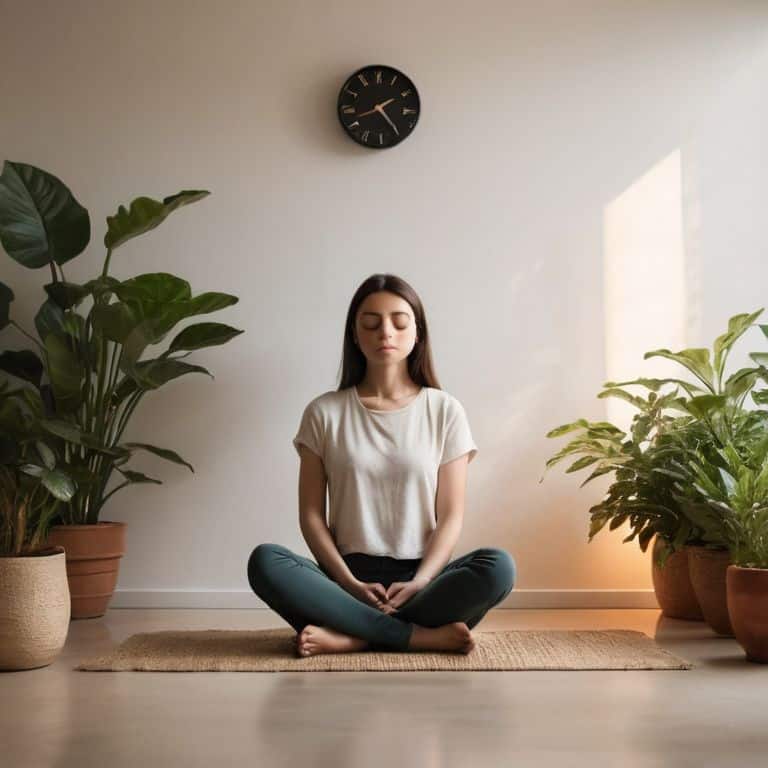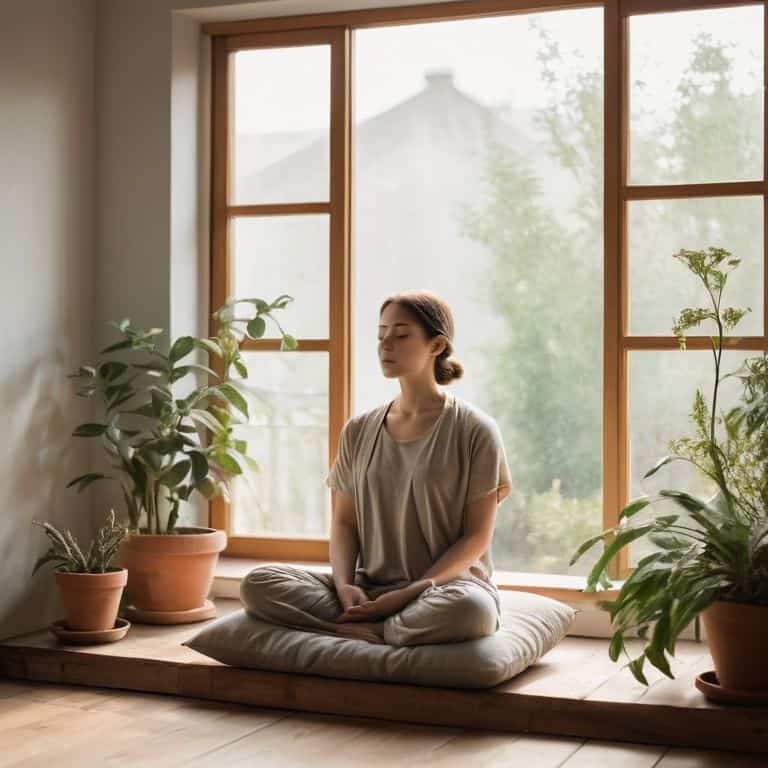I still remember the day I stumbled upon a simple 5-minute mindfulness meditation that changed my life. As a librarian, I’m always on the lookout for ways to manage stress and stay focused. I used to think that meditation had to be this hour-long, intimidating process, but I was wrong. The truth is, even just a few minutes a day can make a significant difference in how you feel. I’ve seen it in my own life, and I’ve witnessed it in the lives of my friends and community workshop participants who’ve started incorporating a simple 5-minute mindfulness meditation into their daily routines.
In this article, I’ll guide you through a straightforward, step-by-step process to create your own simple 5-minute mindfulness meditation practice. You’ll learn how to set aside just 5 minutes a day to breathe, relax, and calm your mind. I’ll share my personal tips and tricks for making mindfulness a sustainable part of your daily life, without any of the typical hype or jargon. By the end of this guide, you’ll have a clear understanding of how to use a simple 5-minute mindfulness meditation to reduce stress and improve your overall well-being. So, let’s get started and take the first step towards a calmer, more focused you.
Table of Contents
Guide Overview: What You'll Need

Total Time: 5 minutes
Estimated Cost: $0
Difficulty Level: Easy
Tools Required
- Comfortable and quiet space (free from distractions)
Supplies & Materials
- Candle or calming background noise (optional)
Step-by-Step Instructions
- 1. First, find a quiet space where you can sit comfortably without any distractions. This could be a corner in your home, a peaceful outdoor spot, or even a quiet room at work. Make sure you’re sitting in a chair with your back straight or on a cushion on the floor with your legs crossed, whichever feels more natural to you.
- 2. Next, set a timer for 5 minutes. You can use a traditional timer, a mobile app, or even a simple clock. Having a set time frame will help you stay focused and ensure you complete the meditation without worrying about the time.
- 3. Close your eyes and take a deep breath. Inhale slowly through your nose, filling your lungs completely, and then exhale slowly through your mouth. Feel the air move in and out of your body, and allow yourself to relax a little more with each breath.
- 4. Now, focus on your breath. Bring your attention to the sensation of the air moving in and out of your nostrils. Try to let go of any thoughts or distractions, simply observing your breath without judgment. If your mind starts to wander (and it probably will), gently bring your focus back to your breath.
- 5. As you continue to breathe deeply, notice the sensations in your body. Feel the weight of your seat on the chair or the floor, the sensation of your feet touching the ground, and the movement of your chest or belly as you breathe. Allow any tension or discomfort to release with each exhalation.
- 6. About halfway through your meditation, gently shift your focus to your body as a whole. Starting from your toes, bring awareness to each part of your body, slowly moving up to the top of your head. As you focus on each area, release any tension or stress, allowing yourself to relax further.
- 7. As your timer approaches its end, take a moment to reflect on how you’re feeling. Notice any changes in your body or your mental state. Perhaps you feel more calm, centered, or grounded. Hold onto this feeling, knowing you can return to it whenever you need it.
- 8. Finally, when your timer goes off, slowly open your eyes. Take a deep breath in, and then out, and slowly get up from your seated position. Take the sense of calm and clarity with you, back into your day, and remember that you can always return to this peaceful state with another simple 5-minute meditation.
A Simple 5 Minute Mindfulness Meditation

As you embark on this mindfulness journey, remember that consistency is key. Incorporating a morning mindfulness routine into your daily schedule can have a profound impact on your mental clarity and focus throughout the day. By dedicating just a few minutes each morning to mindful breathing exercises, you can set yourself up for success and improve your overall well-being.
To enhance your meditation practice, consider exploring body scan meditation techniques. This involves bringing awareness to different parts of your body, often starting from your toes and moving up to the top of your head. By doing so, you can release physical tension and promote relaxation. For those struggling with stress and anxiety, mindful breathing exercises can be a powerful tool for calming the mind and reducing feelings of overwhelm.
As you continue to practice mindfulness, you may find it helpful to utilize daily mindfulness apps to guide you through short meditation sessions. These resources can provide a sense of structure and support, especially for those just starting out. By committing to a regular mindfulness practice, you can experience the numerous benefits of mindfulness for anxiety relief, including increased focus, improved mood, and enhanced overall well-being.
Body Scan Meditation for Daily Focus
To enhance your daily focus, let’s incorporate a body scan meditation into your mindfulness routine. This simple yet powerful technique involves lying down or sitting comfortably, and bringing your attention to different parts of your body. Start from your toes and work your way up to the top of your head, noticing any sensations, feelings, or thoughts without judgment.
As you scan, breathe into any areas of tension, allowing yourself to relax and release. This practice helps cultivate awareness, calmness, and clarity, setting you up for a focused and productive day. Remember, the goal isn’t to achieve a specific state, but to be present with your body and mind, just as they are.
Morning Mindfulness Routine for Calm
To incorporate mindfulness into your daily routine, consider starting with a morning mindfulness routine for calm. This can be as simple as dedicating a few minutes each day to meditation, deep breathing, or even just paying attention to your senses while you enjoy a cup of coffee or tea.
By beginning your day with mindfulness, you set a positive tone and create a sense of clarity that can stay with you throughout the day. You can start with the simple 5-minute mindfulness meditation we’ve already explored and gradually add other mindful practices, such as yoga or a short walk, to create a morning routine that nurtures both body and mind.
Mindful Moments: 5 Key Tips to Enhance Your 5-Minute Meditation
- Start small and commit to a daily routine, even if it’s just 5 minutes a day, to build a consistent mindfulness practice
- Find a quiet and comfortable spot to meditate, free from distractions, where you can focus on your breath and body
- Use a guided meditation app or a calming nature sound to help you relax and stay focused during your meditation
- Be gentle with yourself and remember that it’s okay if your mind wanders – simply acknowledge the thought and gently bring your attention back to your breath
- Make mindfulness a part of your daily activities, such as eating or walking, by paying attention to your senses and the present moment to cultivate a greater sense of awareness and calm
3 Key Takeaways for a More Mindful You
By dedicating just 5 minutes a day to mindfulness meditation, you can significantly reduce stress and improve your overall well-being, leading to a calmer and more focused life
Incorporating a morning mindfulness routine can help set a positive tone for the day, while a body scan meditation can increase daily focus and productivity by teaching you to be fully present in each moment
Remember, the goal of mindfulness isn’t to achieve a specific state, but to cultivate awareness and kindness towards yourself, making it easier to navigate life’s challenges with clarity and confidence
Mindfulness in Minutes
In just five mindful minutes, we can breathe new life into our day, calm the chaos, and rediscover the beauty of being present in every moment.
Hannah Jensen
Embracing Mindfulness for a Calmer Life

As we conclude our journey through this simple 5-minute mindfulness meditation, remember that the key to making it a lasting habit is consistency and patience. We’ve explored how to start your day with a _morning mindfulness routine_ and how to use _body scan meditation_ to increase your daily focus. By incorporating these practices into your daily life, you’ll find that mindfulness becomes a powerful tool for managing stress and improving your overall well-being. Take a moment to reflect on how you feel after just a few minutes of meditation – notice the _subtle yet profound shifts_ in your mindset and body.
As you move forward, I encourage you to embrace mindfulness as a lifelong companion, not just a quick fix. Remember, every moment is an opportunity to _breathe, relax, and renew_. By committing to this simple yet profound practice, you’ll be amazed at how it can transform your life from the inside out. Keep in mind that it’s okay to start small and be gentle with yourself – the goal is to make mindfulness a _sustainable part of your daily routine_, leading you toward a calmer, more compassionate, and more fulfilling life.
Frequently Asked Questions
Can I practice mindfulness meditation at any time of day, or are there specific times that are more beneficial?
While you can practice mindfulness meditation at any time, I find that morning and evening sessions can be particularly beneficial. Morning meditation sets a calm tone for the day, while evening practice helps unwind and prepare for rest. However, feel free to meditate whenever you need a pause – even a short break at lunch can make a big difference.
How often should I practice this 5-minute mindfulness meditation to start seeing positive effects on my stress and anxiety levels?
To start seeing positive effects on stress and anxiety, I recommend practicing this 5-minute mindfulness meditation at least 3-4 times a week. Consistency is key, so try to incorporate it into your daily routine, such as right after waking up or before bed. Even small moments of mindfulness can add up to make a big difference.
Are there any modifications or adaptations I can make to this meditation practice if I have difficulty sitting still or focusing my mind?
If sitting still is a challenge, try incorporating gentle movement, like yoga or walking, into your meditation. For focus, start with guided meditations or shorter sessions, and gradually increase time as you become more comfortable with the practice.
